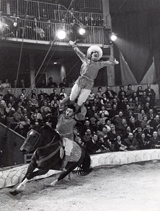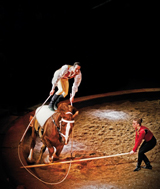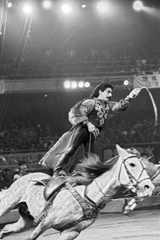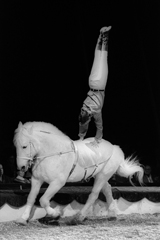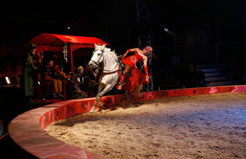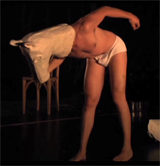by Pascal Jacob
A few centuries of close complicity between man and horse crafted a complex relation between two entities with complimentary yet opposing needs and expectations. The one carries while the other sits astride. One drives, the other pulls, leads, hauls and heaves. One is powerful, but the other is equally capable of being strong and demanding. Associated for almost ten thousand years, the rider and his mount have traversed every plain, crossed every river, trampled every battle field and transformed hostile expanses into fertile land. Part of the circus repertoire and a component of most western companies' programmes until the beginning of the Second World War, the equestrian disciplines have gradually disappeared in favour of exotic animal exhibits and one-upmanship in feats, in particular with the development of the flying trapeze.
From one horse to another
The history of horse riding populations is woven from founding myths in which the horse occupies a central role, both as companion and soldier, in conquests and in work. Its silhouette is omnipresent on the landscape, and it also is the stuff of legend and symbol. This is probably where an intuitive and sensitive reading between the lines leads us to its role and significance in contemporary creations. The equestrian opera, created and directed by Tamerlan Nougzarov in the early 1980s for the Central organization of Soviet Union circuses, followed a historical path by mixing pantomime and equestrian feats to provide a long sequence in which acrobatics, haute école, music, dance, lights, and costumes combine in the service of a symbolic narrative. It was a way of breaking away from the simplicity of other acrobatic companies in which only the costumes added a touch of originality, such as Irbek Kantemirov's company, dressed in long, black or white woollen capes with big shoulder pads. The Nougzarov's work continued from that of the Gonka, an almost exclusively equestrian show created in the 1960s to reinterpret the elegance and spirit of a voluntarily allegorical circus.
Renaissance
On May 25th 1974 in Paris, Alexis Grüss and Silvia Monfort revived a forgotten repertoire by taking inspiration from 19th century drawings and prints, to reinvent the traditional circus. Under a small blue big top set up in the courtyard of the Hôtel Salé, right in the centre of the Marais, and in a place destined to become the Picasso Museum, in a twist of destiny that would surely have amused a protean artist who liked acrobats so much, the Grüss family suddenly gave a contemporary aspect to the circus riders on their panneaux, horse pyramids and the Epsom jockey, shapes straight out of the albums of Victor Adam, Carle Vernet and Toulouse-Lautrec. Over 40 years of creation, Alexis Grüss was to build a unique vision and vocabulary, a process that was both artistic and classical in its era. But above all, by favouring the horse as a powerful aesthetic support, he announced the coming transformations.
In the 1980s, the equestrian art revival happened as young riders took up the conventions again and created new companies in which the horse set the pace. The Cirque Bidon drew largely on the footsteps of its horses, pulling heavy caravans along roads in France and Italy, and reinventing the long caravans of the 19th century, using the animal as seductive poetic license more than just a means of traction.
In 1985, Patrick Grüss and Francesco Caroli were the first to teach the equestrian arts at the newly opened National centre for circus arts in Châlons-en-Champagne. Bernard Quental and Manuel Bigarnet, riders from the first graduating class, joined the Théâtre Équestre Zingaro upon graduating. After seven years with Zingaro, Bernard Quental worked with the Théâtre du Centaure in 1998, and participated in the creation of Cheval Théâtre in 2000. The presence of the horse in an Ecole Supérieure was symbolic of the revival of these forms and suggested a contemporary aspect of the equestrian art. Fascinated by equestrian bullfighting, Bartabas also drew largely on myths and legends to compose his shows, from the creation of the Circo Zingaro to Sigma de Bordeaux in 1986. He was inspired by the Tzigane world and explored polyphonic Berber traditions and the voices of the Caucasus. He used in turn, music from Rajasthan in India, the Korean pansori, the sounds of Mexico and Mongolia, and the Klezmer song, for powerful shows in which the horse was both the basis and the support for sumptuous images, that were a pretext for an aesthetic celebration, and a driving force for figures in a repertoire marked by academism.
Filiations
The Théâtre du Centaure, created in 1989 by Camille and Manolo, based its work on the complicity between the rider and his mount, to compose a new form based on the principle of the actor horse. Les Bonnes by Jean Genet and Macbeth by William Shakespeare are the expression of the fusion between animal, performance and human, but above all, these shows enabled the presentation of a new type of composition in terms of equestrian art. In a similar register, by creating the show Golgotha together, the rider Bartabas and the choreographer Andrés Marin merged an instinctive and contemporary flamenco with the power of four horses carried away in a dance of shadows, supported by 16th century Spanish songs. The combined elegance and force of the dancers and the horses abolished the distance between man and animal. There were only vibrant bodies, symbolically combined, powerful and enigmatic. Both ritual and spectacular, the original encounter reflected the origins of the world, and an era where myths and realities still merge, and the animal embodied hope as much as doubt. Integrating this skilful equestrian vocabulary into an organic and coded dance, in which feet and hooves transfigured rhythm and shaped the audience's experience, functioned as a magnificent aesthetic and technical symbiosis.
In the early 2000s, Gilles Sainte-Croix, a performer and outstanding rider, decided to make an old dream come true and created Cheval Théâtre in Montreal, an equestrian fresco designed for a big top painted with an elegant pebble dash, similar to the coats of certain dappled horses. He called on European riders and acrobats to create a succession of tableaux for which François Barbeaux's costumes composed a sumptuous visual framework. A few years later, still in Quebec, the producer Normand Latourelle created Cavalia, a show developed with rider Frédéric Pignon, designed and directed by Erik Villeneuve in his gigantic big top with a stage space capable of multiple transformations, in particular through the means of projections on moving surfaces.
References
Sometimes the horse is nothing more than a simple wooden, metal or cardboard shape, in a nostalgic nod or amused reference. The Trottola circus ended one of its shows with a wooden and iron horse, mounted on wheels, that turned on its axis, and was a pretext for a classic acrobatic act, in which the evocation of the animal was sufficient to enable the audience's imagination to suspend disbelief and enjoy the performance.
One of the sequences in Obludarium, by the Forman brothers, powerfully imbued with gentle melancholy, borrowed from the same source: a large, articulated wooden horse puppet made an impressive mount, larger than life, for a magical moment in which the very real rider, on a panneau, seemed to have escaped from a Toulouse-Lautrec picture.
L’Homme Cirque by David Dimitri also incorporates a simple wooden horse, as an acrobatic support and a nostalgic nod to the past. This poetic depiction of equestrian movement was terribly effective and revived the romantic circus with humour. It is a reverence distanced from the past and a manner of making a forgotten discipline timeless.
For several years, Charlène Dray, a stage designer and artist has developed research and experimental work that is part stage design, part equestrian art and part contemporary performance, with hippo-néguentropie a process that invents for the horse, in its name, for its use. The performance imagines interfaces that enable the horse to be placed on stage and to anticipate its reactions faced with certain situations: finding and controlling constants, mastering the random, and redesigning a form of improvisation with a complicit horse. By suggesting the animal as an artistic constraint, Prologo 97 by Iannis Kounellis created a spectacular device composed of hundreds of suspended crystal glasses that created a monumental yet fragile curtain, that a rider and horse would go through in the ring of the Compagnie Foraine, for ReVu Rue Marcel Duchamp. This was a way for the horse to integrate the contemporary arena by offering us its finest transformations: complicit partner, actor and vector of the imaginary.



